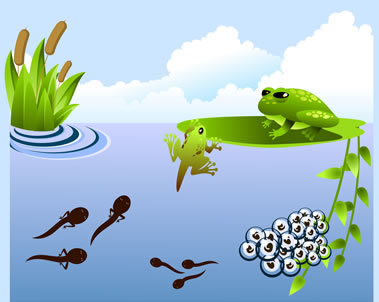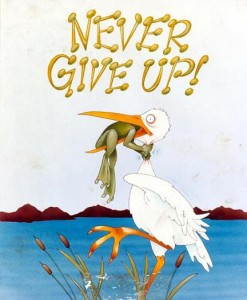What is a frog?
Let’s start by seeing where an American Bullfrog fits into the web of life - known as its taxonomy. It all looks like this:
Kingdom - Animalia
Phylum - Chordata (those animals with spinal cords)
Sub-phylum - Vertebrata (spinal cords protected by a backbone)
Class - Amphibia (means “twin life” - part in water, part on land)
Order - Anura (means “tail-less”)
Family - Ranidae (these are the True Frogs)
Genus - Lithobates
Species - catesbianus
When describing the bullfrog he would be Lithobates catesbianus (this is known as the frog’s binomial nomenclature). Notice that his name is in italics and only the first name is capitalized.
What is the difference between a frog and a toad?
Let’s compare them side by side:
Frogs | Toads |
|---|---|
| Eyes can look in all directions | Eyes tend to face forward |
| Lay their eggs in clumps, singly, or in floating films | Lay their eggs in long strands |
| Slim bodies and long legs for leaping | Fat bodies and short legs for hopping |
| Long tongues with good aim | Short tongues with excellent aim |
| No separate toxic glands | Toxic Parotoid Glands on back of head |
| Live close to and in water | Live on land |
| Smooth or slimy skin | Dry and warty skin |
| Small upper teeth only | No teeth |
Not all frogs and toads fall neatly into these categories, but most do.
The Frog and Toad Life Cycle
 The frog lays its eggs (as many as 20,000) in a clump (toads in long strands). The eggs are called Frog Spawn. They hatch into tadpoles (the larval stage) which look like fish. The tadpoles have gills and a tail and special jaws for eating vegetation.
The frog lays its eggs (as many as 20,000) in a clump (toads in long strands). The eggs are called Frog Spawn. They hatch into tadpoles (the larval stage) which look like fish. The tadpoles have gills and a tail and special jaws for eating vegetation.
Why are there not 20,000 tadpoles in the pond?
As the pollywogs (another name for tadpoles) mature, they begin to grow hind legs. Their jaws begin changing shape and their gills are replaced with lungs. Front legs emerge and the tadpole now looks like a tiny frog with a tail.
It makes its way out of the water to its edges as its tail is gradually absorbed. The frog now breathes with lungs, has no tail, and eats insects by catching them with its sticky tongue.
Remember that frogs and toads are Anurans which means “tail-less.”
This transformation is called metamorphosis. It can take place in a matter of days or over the course of a year depending on the species and the availability of water.
Frogs and Toads have special skin
First of all, their skins are permeable to water. That means they can get all the moisture they need by absorbing it through their skin. They don’t have to drink water like we do. Frogs can just leap into the pond if they are thirsty. Toads can settle into some damp dirt and absorb moisture through their belly. Treefrogs can absorb moisture through their tummy by clinging to the side of a tree.
But that’s not all! Their skins are also permeable to oxygen. They can breathe through their skin. In the winter many frogs will hibernate at the bottom of the pond for months - they get their oxygen supply through their skin from the dissolved oxygen in the pond water. Are these creatures amazing or what?
But that’s still not all! Frogs and Toads use toxic secretions from their skins to deter predators. Some of the toxins are strong enough to kill a dog.
You don’t want to get the secretions in your eyes or near your mouth or nose because they will cause you great discomfort. Wash your hands thoroughly after handling any frog or toad, and put them back where you found them.
 The toxins of some frogs are some of the deadliest substances on Earth. Natives in Central America use the skin toxin of Dart Frogs to coat the tips of the darts used in their blowguns. A monkey hit with the poison dart will die instantly.
The toxins of some frogs are some of the deadliest substances on Earth. Natives in Central America use the skin toxin of Dart Frogs to coat the tips of the darts used in their blowguns. A monkey hit with the poison dart will die instantly.
And finally, chemical compounds found in frog skin secretions have been used to make amazing medical discoveries. “Miracle Drugs” such as a pain killer that is more effective than morphine, but non-addictive and potential treatments for the most deadly cancers are some of the benefits.
Where do frogs fit into the Food Chain?
They are smack dab in the middle of it! Let’s start with the eggs. Why does the female lay hundreds, thousands, or tens of thousands of eggs? Everybody and their cousins eat the tasty morsels if they can break into the egg mass.
Interesting Fact: Even frog eggs are smart! In a study by Alicia Mathis at Missouri State University it was determined that Wood Frog embryos were learning to detect predators while still in the egg!
Many of the eggs will hatch into active, plant eating tadpoles. While fattening up on the plants and detritus of the pond, several hunters are scoffing down as many tadpoles as they can find. Predators include fish, birds, insect larvae, and frogs.
 Adult frogs and toads are eating machines. Although most are just insectivores, several of the larger varieties, like Green Frogs and the American Bullfrog, will eat anything that they can jam into their mouths and swallow. And who eats frogs? Snakes, fish, small mammals, lizards, birds, us and even other frogs will eat frogs. Some snakes, like the Hognose and Garter, are tolerant of toad toxins and seek them out with a passion.
Adult frogs and toads are eating machines. Although most are just insectivores, several of the larger varieties, like Green Frogs and the American Bullfrog, will eat anything that they can jam into their mouths and swallow. And who eats frogs? Snakes, fish, small mammals, lizards, birds, us and even other frogs will eat frogs. Some snakes, like the Hognose and Garter, are tolerant of toad toxins and seek them out with a passion.
But here’s the really interesting part of frog biology. Since they are ectothermic animals, they use little to no energy to maintain their body temperature. So what happens to all that food they eat? They keep growing - all their lives. Why do you think I give the size of an American Bullfrog as 3″ - 8″? As adults they keep growing.
Interesting Fact: The Energizer Bunny has nothing on the Energizer Frog.
Solar energy is changed to plant matter by photosynthesis. That is eaten by tadpoles that grow into frogs who keep eating and growing until something eats them. This is a very efficient transfer up the food chain of solar energy.

